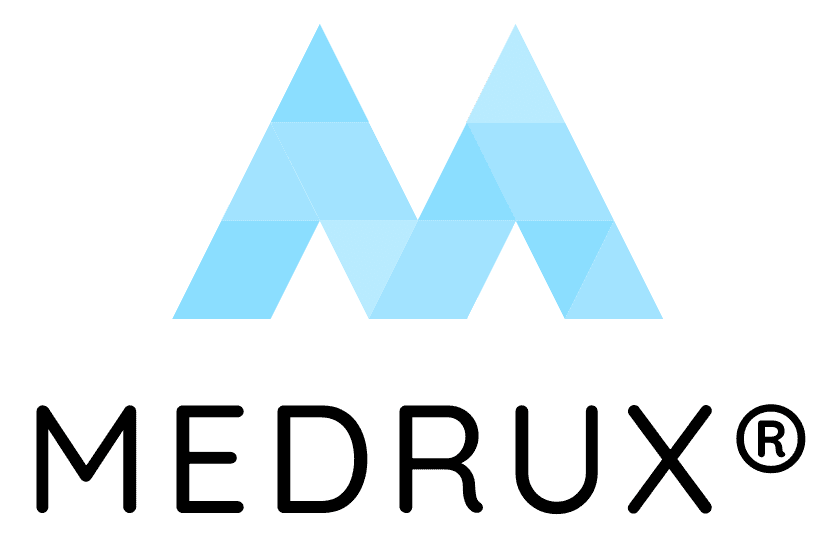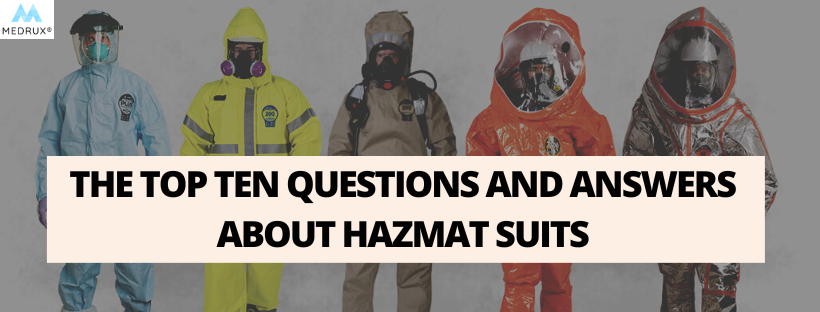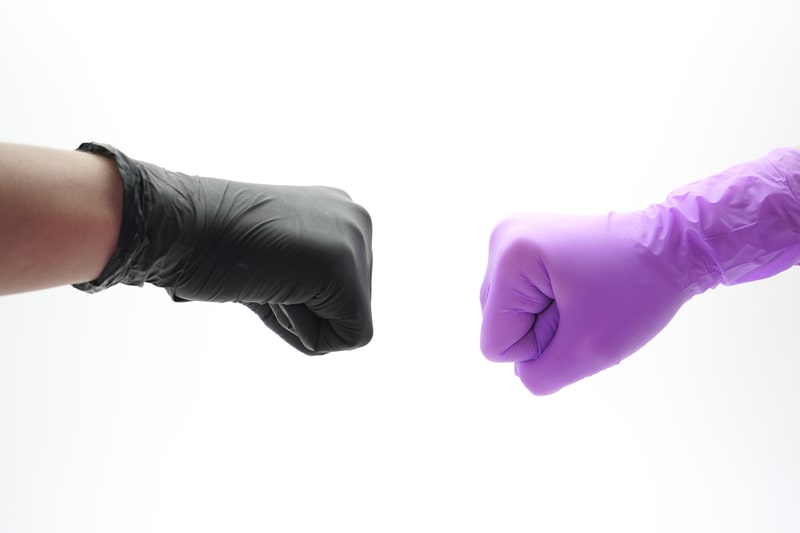Hazmat suits?
Yes, I need to know everything about it because I have searched on many websites and I haven’t found anything!
If you are this person, this article is totally for you! Let’s start!
The proper protection always matters! When you are fully aware of the types of hazards and substances you need protection from, this helps you decide on the ideal personal protective equipment (PPE).
Are you dealing with chemicals? Explosions? Vapors, gases, and particulates all over the place? The outbreak of epidemic disease? Biological hazards? That is precisely what hazmat suits function for!
Hazmat combines the words (Hazardous) and (materials). These materials can threaten human health, wildlife, and the surrounding environment.
They require very cautious and professional ways of protection. Protection for the surrounding biotic and abiotic factors and for workers whose priority is keeping the danger of hazmat away from us.
We are not through yet!
Do you want a complete guide on the hazards that hazmat suits can overcome? Which fields of work require using hazmat suits? The different levels of protection ad their requirements?
Want to know if all hazmat suits are the same? Different colors of hazmat suits and why there are colors? Want to know why there’s a difference in cost and if they could be reusable or not?
Keep reading, and you will find out the answers to your questions! Can you beat that?
Let’s dive in!
Levels of protection
There are four levels of personal protection from hazardous materials.
Levels are given labels from A to D.
Level A represents the maximum protection required. On the other hand, level D represents the minimum protection level required.
The four levels clarify the levels of exposure to hazardous materials and the entire suit pieces of equipment needed for each levclassAccording to the United staStatesvironmental Protection Agency; the four groups are:
Level A protection
It is required when the tremendous significance of exposure to hazards exists ad when the most significant level of skin n, respiratory, and eye protection is needed.
Examples of Level A clothing and equipment include:
- positive pressure, complete face-piece self-contained breathing apparatus (SCBA), or positive pressure supplied air respirator with escape SCBA;
- capsulated chemical- and vapor-protective suit.
- inner and outer chemical-resistant gloves
- the disposable protective suit, gloves, and boots.
Level B protection
Under the circumstances requiring the highest level of respiratory protection, with a less ser level of skin protection, level B protection is essential.
At most abandoned outdoor hazardous waste sites, ambient atmospheric vapors or gas levels have not approached sufficiently high concentrations to warrant level A protection. Examples of Level B protection include:
- positive pressure, complete face-piece self-contained breathing apparatus (SCBA), or positive pressure supplied air respirator with escape SCBA;
- inner and outer chemical-resistant gloves
- Face shield
- Hooded chemical-resistant clothing
- Coveralls; and outer chemical-resistant boots
Level C protection
It is required when the concentration and type of airborne substances and the criteria for using air-purifying respirators are significant.
Typical Level C equipment includes:
- full-face air-purifying respirators;
- inner and outer chemical-resistant gloves;
- hard hat;
- escape mask; and
- disposable chemical-resistant extreme boots.
Level D protection
It is the minimum protection required.
Level D protection may be sufficient when no contaminants are present, or work operations preclude splashes, immersion, or the potential for unexpected inhalation or contact with hazardous levels of chemicals. Appropriate level D protective equipment may include:
- gloves;
- coveralls;
- safety glasses;
- face shield; and
- chemical-resistant, steel-toe boots or shoes.
Jobs that require hazmat suits
Hazmat suits are essential for various professions because of exposure to hazardous materials. Here are some examples of office jobs:
1. Nuclear inspector
Hazardous chemicals, nuclear radiation,d toxic vapors are around nuclear inspectors everywhere in their work fields as reactor sites.
This requires Level A hazmat suits during routine inspections, and emergency needs to wear them all the time.
2. Firefighters
You may not be familiar with firefighters wearing hazmat suits, but not all emergency fires are the same!
Some are not free from toxic chemicals.
It means that the nature of the materials causing the fire requires different protective personal equipment for firefighters.
Firefighters have two types of hazmat suits to wear; the first is an aluminized suit with complete SCBA breathing apparatus plus an air tank to fight fires.
The second type used at the site after the fire is finished required style is the standard Level B or C hazmat suit with a respirator.
Two types in both cases prevent the damage that may result from exposure to chemicals or vapors from burning embers.
3. Mold Remediation technicians
Mold Remediation demands essential protection as hazmat suits provide to avoid contact of mold hazards with skin, eyes,d mouth.
Some mold types can be so dangerous and lead to severe health effects.
Level B and C hazmat suits can be good, providing enough protection in such cases.
4. Construction workers
Some construction materials can be toxic or corrosive, for example, asbestos.
Asbestos has been carcinogenic in floors, walls, and ceiling insulation for years.
Exposure to asbestos and breathing in asbestos dust may cause severe health effects, so it requires a Level B or C hazmat suit.
5. Soldiers
Are you familiar with soldiers ever wearing hazmat suits? Have you watched movies about wars or soldier battles since the early 90s?
Yes, deaths are because of the danger of exposure to chemical weapons hazards!
Different chemical or biological weapons use lead to the disclosure of vapors, smoke, infectious diseases, or chemical wastes from weapons and vehicles.
Wartime hazmat suits are special military-grade compact full suits with a gas mask.
6. Healthcare workers
Most healthcare crews must wear hazmat suits, especially in cases with many infected patients to treat!
Although the daily scrubs are often doing their job of limiting the transmission of infections, some workers may demand a hazmat suit for higher protection against biological or airborne substances.
Surgical setting scrubs are equivalent to a Level D protective hazmat suit.
An outbreak of infectious, deadly disease or biological agents that occurs in the community requires wearing full hazmat suits of Level B or C by health care professionals.
During outbreaks, using hazmat suits was lifesaving, like when Ebola struck West Africa in 2016!
Medical crews and other volunteers mobilized across the continent to lend a hand of help with close contact with patients wearing hazmat suits.
It was essential because of the high fatality rates and ease of transmission from one to another, causing the outbreak to occur.
6. Astronauts
I know what you are thinking; possibly, you have seen pictures or videos of astronauts before, and all you’ve assumed is they have specially designated suits for space but hazmat suits?
Probably this hasn’t come to your mind before.
ActTheseecial suits need to be hazmat suits to protect against radiation. Space is full of radiation.
Without proper protection and insulation, astronauts would probably die in space and be unable to fulfill their missionary duties.
7. Other jobs
DefTheeviously mentioned jobs are examples of remarkable work fields requiring protection from different levels of hazardous materials.
Other jobs that require this radiation, toxic chemical, and carcinogenic to achieve their tasks would probably require protection of similar levels as toxic waste cleanup workers, infectious diseases researchers,d crime scenes investigators.
Disposable or Reusable?
The cool thing is there are reusable and disposable hazmat suits. You may be wondering why both types are available, so let’s find out:
Disposable hazmat suits
Hazmat suits are disposable.
One of the most remarkable advantages of using disposable hazmat suits is that they are lighter to wear and provide the user with comfort.
But this is just the tip of the iceberg; disposable suits are inexpensive compared to reusable ones.
They are more money-saving, not just for their prices but because they have zero maintenance costs.
Safety! Moreover, some disposable hazmat suits have integrated gloves, socks,d boots, which makes wearing them on and taking them off much easier accessible year here it is. What could be more important?
A disposable suit can be highly safe for the personnel wearing it.
Anyone can wear it, remove and dispose of it immediately, minimizing the risk of hazardous contact.
In addition, their disposal decreases the risk of cross-contamination by mistake or the transfer of chemicals to the surroundings, saving the environment and adequately disposed of.
Does this mean that disposable suits are flawless?
Although there are various advantages provided by using disposable suits, they are against sustainability!
Throwing away the suits after each use results in increasing hazardous waste.
Disposing and processing all these suits can be environmentally damaging in another way!
Reusable hazmat suits
There are many points about reusable suits that are obviously opposed to using disposable suits, as they are heavier to wear, less comfortable, and need maintenance and thorough cleaning.
Regardless of the maintenance costs, the reusable suits have different prices; soon, you’ll have them in your pocket.
However, remember that if they meet your standards of safety, protection is priceless!
But is that all? Of course not!
The odds are that reusable hazmat suits are mechanically more robust and durable! Therefore, if you need protective suits more often, they would be more helpful.
They are more sustainable for the environment as you buy fewer suits, only a few reusable ones now and then.
What makes it more worthy is they can work for a more extended period where the right conditions.
On the other hand, disposable suits need to be deposited in the bin soon after you’ve opened the packaging, even if they are not exposed to contamination.
What about the wearer’s safety?
Reusable suits are safe for the user if they are appropriately decontaminated, sterilized, and correctly re-rested for leaks under pressure.
In short, wearing a disposable or a reusable hazmat suit is all based on the work conditions, safety measures available, priorities, and perspectives.
How about the hazmat suit colors?
Pink, white, yellow!
Hazmat suits are available in different colors. Some colors are indeed used by professionals and have professional significance! Others are rarely used or just preferred for personal uses.
I’d love to help you know more about colors’ significance, so here we go!
1. Yellow hazmat suits
Yellow hazmat suits are ideal for emergencies in public. People in unsafe areas can well observe thems. This is because the yellow color is familiar with safety and is associated with caution.
2. Red hazmat suits:
The red color represents danger!
It’s evident to alert others. That is why Level A hazmat suits are often available in red to deal with dangerous materials and infectious diseases.
3. Blue Hazmat suits
Blue hazmat suits are available in bio-research labs or places of hazardous biological chemicals.
The blue color is associated with medical and biological hazards.
4. Silver Hazmat suits
The silver color is not very popular for hazmat suits, but it has an excellent specific reason.
It’s reflective to keep the case from getting too hot when exposed to intense heat.
Silver hazmat suits are often used by geologists who work near active volcanoes or firefighters to keep cool in extreme emergencies.
5. White Hazmat suits
White hazmat suits are commonly available as single-use suits. This is because it helps workers to feel more relaxed. Medical fields prefer white suits to other colors.
6. Pink Hazmat suits
Pink hazmat suits are available in a wide range. They can be purchased and worn by anyone.
They have no exact professional significance, but users may prefer them to provide favorable impressions during the tension of emergencies.
Final thoughts;
The bottom line is, whatever the circumstances, you will find a proper hazmat suit or general PPE to provide the required protection!







